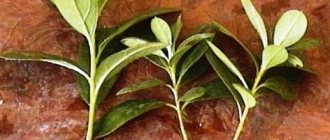Rose grafting: theory
Grafting roses onto rose hips is the main method of rose propagation. Spring is considered the best time of year when this procedure can be carried out most successfully. When planning to graft a plant, gardeners prepare in the fall.
The main key technical concept in the grafting section is budding. This term refers to a method of grafting a rose, when a specially grown rootstock bush is taken - a rose bud is grafted onto it. Usually the rootstock is rosehip, but there are other ways.
To successfully propagate rose varieties, vegetative methods are used.
When trying to obtain flowers from seeds, the result is mediocre: the resulting flowers are deprived of their original data, which is associated with a high level of splitting of these data during seed propagation.
For high-quality grafting, excellent compatibility of the rootstock and scion is required. Without this, the kidney will not take root. Incompatibility sometimes appears later, when already mature plants begin to break at the budding site. If the fusion of the rootstock with the scion is as good as possible, then this will ensure both the growth and flowering of the new plant.
What should the scion be like?
The key to successful vaccination is the correct choice of graft. To get a scion from the mother bush, you need to cut off the most mature branches. Next, their middle part is separated.
The scion should have smooth and shiny bark, as well as developed buds. Branches with such characteristics are grafted very easily.
Experienced gardeners, in order to increase the chances of better survival, advise using the budding method. This method will be discussed below. Its use guarantees 90–100% vaccination effectiveness. Here one bud is taken, and not a whole cutting.
Why do roses turn wild?
Amateur flower growers often wonder what is the reason that a rose turns into a rose hip as it grows. This may be due to the gardener’s lack of experience or poor quality planting material.
In the photo there is a wild rose
Some seedlings leave rosehip buds in places below the grafting and, thus, when the root system is already formed, these buds throw out shoots. New shoots drown out previously grafted shoots, taking away nutrition. The rose also runs wild due to poor choice of rootstock.
There are rosehip varieties called “early ripening”: they have aggressive, fast growth and are poorly suited for grafting. The new growth choke out the grafted crop, preventing it from growing.
The rose also turns wild due to mistakes made during planting. When the grafting site is not deepened into the ground, the scion quickly weakens and is drowned out by rose hips. When the plant is not hilled up or wrapped up with the arrival of the cold season, this also becomes the reason for the degeneration of a cultivated rose into a rose hip.
Timing of rose hip grafting
The best time to graft roses is in the summer, somewhere in the last ten days of July or the first of August. It is then that sap flow increases, the bark easily moves away from the wood, and the graft takes root better.
In the spring, vaccination is also possible, it is better to do it before the buds break, this is somewhere at the end of April or the very beginning of May.
It is most difficult to vaccinate in winter, as there is a lot of hassle. First, young seedlings are planted in containers and grown in the basement, and cuttings are prepared in the fall and stored in a cool place.
What you will need in the process:
- Rosehip is a rootstock, one-year or two-year-old.
- Cuttings taken from the middle part of the cultivated stem.
- A sharp knife or grafting pruner.
- Garden varnish for lubricating cuts.
- Dressing material - electrical tape, pieces of polyethylene, special garden dressing tape.
When to graft roses
Speaking about the time of vaccination, the best time for vaccination is spring. The first leaves and young shoots are showing on the rosehip bush. You must not miss the deadline, otherwise the young stems will begin to grow. Rosehip bushes should not be disturbed during bud dormancy.
But it is also possible to plant roses in the summer. At this time, active movement of juice begins in the stems, which has a beneficial effect on the rapid establishment of rose cuttings. Young shoots, when they fade, can be used as a scion. Work begins in July or August.
These flowers can be grafted even in winter - in February. This method is more labor-intensive and therefore not so popular. During this period, cuttings take root much worse.
Budding instructions
Any beginner must know how to graft a rose onto a rosehip. This procedure is divided into several stages.
The photo shows rose budding step by step
How to choose the right rootstock
- When choosing a rootstock, preference should be given to varieties with high cold resistance.
- The variety must also be resistant to fungal diseases. Rose hips fully meet these requirements. Another positive point is the small number of thorns that interfere with the grafting procedure. All these reasons force gardeners to choose rose hips as a rootstock.
- Rootstock plants must be strong and healthy. Must be at least one year old, but not more than five years old. The optimal thickness is up to 7 mm.
- About two weeks before budding, loosen the rose hips and make sure the soil is moist. The day before the grafting procedure, the rose hips are watered with slightly warmed water without lime.
- A little later, just before grafting, the soil from the bush is raked off and the root collar is exposed. It is washed well with water and rubbed with a napkin on the place where the vaccination will be done.
Preparing rose buds
When carrying out summer budding, the scion material is prepared immediately. If the grafting is done in the spring, before the buds open, then the cuttings are stored in the fall. They must be stored in a cold place, for example, a basement or refrigerator with a temperature of minus 4 - plus 1. The day before cutting the cuttings, the plant is moistened abundantly.
Preparing rose buds
Description of the grafting process
It is advisable to carry out vaccination in the morning, before the moisture has dried under the influence of high air temperature. The weather should be warm, without rain.
- On the day of the procedure, full shoots, up to 5 mm thick, are taken from the rose. One larger bud is selected from the middle part of the shoot - it will be used as grafting material.
- On the wiped and prepared root neck of the rootstock, carefully cut the bark in the form of a large T. On the scion shoot, carefully bend the shield and cut it at a shallow depth, dividing the petiole along with the bud. The edges of the cut on the rosehip are slightly unfolded with a knife and a bud is inserted into the formed gap.
- The bud is pressed tightly to the rootstock, trying not to break it. The budding area is well tied with a garden tourniquet, but the eye must be open.
- After grafting, the plant needs to be covered with loose and moist soil. After a couple of weeks, you can examine how successful the vaccination was. If the leafy black has fallen off, but the bud remains green, it means that the fusion of the rootstock and scion has given a positive result.
- The length of the shield cannot be less than 3 cm: with a larger area of contact, the chance of survival increases.
- Tools must be as sharp and disinfected as possible. Gardening photodegradable tape is usually used as a strap; you can use electrical tape or polyethylene.
Why graft roses?
The goal of any gardener is to breed flowers and increase the collection of varieties. Roses in home floriculture are propagated vegetatively. It is often practiced to root cuttings from bouquet roses. A root plant is obtained by cuttings.
The problem of frost resistance is solved by rose hips, which gardeners successfully use as a rootstock.
Grafted roses have a number of advantages over rooted roses. Arguments in favor of rosehip vaccination:
- the grafted plant has greater vitality;
- begins to bloom early;
- has good immunity;
- not afraid of winter frosts.
You can use a different variety of rose as a rootstock. The point is to accelerate development, to bring the flowering period of the rose closer due to the well-developed and fast-growing root system of a different variety.
In temperate climates, it is recommended to use Rósa canína - dog rose. This shrub grows in the European part of Russia, Crimea. Rosehip rootstock is ideal for growing roses in alkaline and slightly alkaline soils. Other varieties can be used as rootstock:
- multi-flowered rose (multiflora Thnb) - suitable for southern regions with mild climates;
- Far Eastern rose (rugosa Thnb) - used for breeding vigorous and park varieties of roses;
- Chinese rose (rosa chinensis).
Terms
Key terms to understand:
- Scion.
- Rootstock.
- Cutting.
- Peephole.
- Neck.
Rootstock is a plant that is grafted into the root collar or stem.
A scion is a part of a plant (bud, cutting) that can take root and continue to develop on another plant - a rootstock, preserving varietal characteristics.
A cutting is part of an annual shoot with buds.
The eye is a bud located in the leaf axil.
The neck is a small segment at the junction of the root and the trunk.
Grafting method: copulation
Copulation is a grafting method with two or three eyes. This method is considered the simplest and is suitable even for beginners. It is better to graft roses in early spring, before the sap begins to flow. To carry out grafting using the copulation method, the main thing is the same diameter of the rootstock and scion.
On both sides, an oblique cut is made, maintaining the same angle of inclination. You need to be able to make cuts in one movement; for this, the tool must be well sharpened. After making the cut, the rootstock and scion must be combined and tightened with a tight bandage.
Rules for copying
- Cuttings for copulation should be taken care of in November.
- Make cuts with a perfectly clean, disinfected and sharpened instrument. You can take a garden knife or a special grafting pruner.
- Do not dirty the cut area, otherwise there is a risk of infecting the plant. Therefore, it should not be touched with crayfish. If the scion suddenly falls to the ground, it is rinsed in water, and the cut itself is renewed.
- The junction is wrapped very tightly. This will retain moisture and ensure the graft is secure.
- It is better to carry out copulation in the evening or on a cloudy day. It is unacceptable to do this in hot or rainy weather.
- Well grafted cuttings grow actively. As soon as they grow three centimeters, the bandage can be removed so as not to overtighten the plant. The grafting site is covered with garden varnish.
Budding - eye grafting
Budding is a common grafting method. The scion is a single bud or eye, as amateur gardeners call it. The eye is taken from a cultivated shoot and grafted onto the trunk of wildflowers.
In the spring, the peephole formed last summer is used. It can be taken from shoots harvested in the fall or in February. This bud will give rise to a new shoot in the same year.
In the summer, the vaccination is done with the bud of the current season, cutting it off just before the procedure. It will slowly take root, overwinter and give rise to new shoots only in the next season. Therefore, gardeners call such a peephole “sleeping”.
Tools and strapping material
Grafting is an operation and its implementation requires not only the skillful hands of a gardener, but also high-quality gardening tools. To work with the material (scion, rootstock), you can use the following tools:
- grafting pruner;
- budding knife;
- gardening scissors.
The grafting pruner has replaceable knives and makes it easier to make cuts of the same size on scions and rootstocks. Well-made cuts guarantee a good result. Cut the cuttings with garden shears. Models made of high-strength steel, small in size, with rubberized handles are easy to use.
Purpose of the budding knife: to make even T-shaped cuts, cut off the shield. The blade has a special knuckle for separating the bark from the wood. The edge is sharpened on one side, the sharpening angle is sharp. The quality of the steel from which the blade is made and its thickness are important; it should not exceed 2 mm. To sharpen the blade, you need a coarse-grained stone and Goi paste for polishing.
On a note. The result of grafting depends not only on the quality of the instruments, but also on its cleanliness.
You can make the strapping material yourself or purchase it at a specialized store. Usually they simply cut the tape to the required width from a suitable material:
- polyethylene film;
- medical oilcloth;
- electrical tape.
When budding, the width of the tape is 15 mm, the width of the strapping for fixing the cutting is 25 mm.
Grafting standard roses
Standard roses are easily recognized by their beautiful, lush crown, which is supported by an elongated standard. This is an exclusively cultivated plant; it does not grow in the wild. Standard varieties are budded in the same way as ordinary roses.
- Before the rose grafting procedure, the rootstock is cleared of soil, washed, dried and a classic T-cut is made. Several eyes are taken from a standard rose, without the bark shield. A cut is made on the rootstock, and without removing the knife, they move the edges of the bark with it and fill it with the shield of the new bud. If it does not fit, it is reduced by taking away the side parts of the shield.
- After placing the eye into the incision, the bark is tied as tightly as possible. The classically correct option: length 19-20 cm, width – 1 cm. This will ensure the closest contact between the trunk and the shield.
- After two to four weeks we can talk about the effectiveness of the vaccination. During this time, the bud will swell and the leaf will fall off. If the attempt is unsuccessful, the bud will dry out or turn brown.
Standard rose pruning method
Photos of standard roses
Grafting roses onto rose hips on a standard
Further care
Caring for the bush involves excavating its root collar 14 days after the procedure. The accepted bud will be green. If the kidney is not accepted, the vaccination is repeated.
A bush with a scion is cared for in the same way as a regular rose. For the winter, pruning is carried out. The shoots located on the grafted bud are cut to 1.5 cm. The plant itself is covered with leaves and soil. The top of the bush is covered with protective material. Such protection will allow the plant to survive even severe frosts.
Features of spring vaccination
When budding in the spring, mature buds are used that have overwintered in a cold place and are ready to germinate. This type of grafting is called budding with a germinating eye. As a rule, shoots harvested in the fall are used. Sometimes you can take material from a bush that has successfully survived the winter. The cuttings are carefully inspected for damage or disease.
Sick, dried out, blackened ones should be selected immediately.
Spring budding is worked out according to the generally accepted algorithm. After its completion, the rootstock is pruned. The height of the cut should be 1/3 of the length of the cutting.
The only convincing indicator of the success of rose grafting is the germination of the eye. Without this, you will have to try budding again in the summer.
If the vaccination is done in the spring, the strapping is left for a year. To avoid constrictions and damage to the bark, elastic materials are chosen.
Features of summer vaccination
Summer budding of roses onto rose hips is called dormant eye grafting. This is due to the fact that the bud appeared in the new year. If the scion and rootstock have taken root, full development and growth will be possible only with the arrival of a new spring, that is, after wintering.
The leaf blade is removed from the scutellum, preserving the petiole. This petiole will signal how well the graft has taken root or died.
After one and a half to two weeks, the blackberries are checked. Upon contact, it falls off, and the eye remains green. These signs indicate the success of rose grafting. Otherwise, the vaccination will have to be done again.
The graft cannot be frozen, so before the onset of cold weather the plant is mulched and covered. Mulch should be a material that retains heat well, such as peat or sawdust. The plant also needs to be protected from rodents, which often attack during wintering.
In spring, the plant is freed from excess soil and bulk material, otherwise it may rot. The binding is removed so that there are no ties. The plant is cut at a height of one centimeter above the grafting site. This, in turn, better activates the growth and development of the new kidney. Then the rose is hilled up again, making the mound higher.
Summer rose budding
Summer budding is called budding with a sleeping eye, because after grafting the bud does not begin to grow, but “sleeps” until next spring. In the middle zone, the best time for it is from July 15 to August 15. At this time, intense reverse sap flow occurs, and the bark lags well behind the wood.
Eye for budding
For grafting, mature shoots are cut off, in which the thorns are easily separated and the buds-eyes are well formed. The leaves are removed, leaving the petioles. It is better to prepare cuttings (shoots) immediately before grafting, but if necessary, you can store them for a month at 2–4 °C in a plastic bag, wrapped in moistened paper. Budding can also be carried out in the spring, during the period of the first intense sap flow. It is called budding with a germinating eye because the grafted bud will soon germinate. It is often used to re-graft failed last year's buddings.
Reproduction of roses by budding
Key points for winter budding
Winter budding of roses occurs in the first two months of winter - January and February. In December, budding is not carried out due to low light activity. When choosing a rootstock, choose young rose hips, harvested in the fall. They are planted in containers with turf and placed in the basement or other cool, dry place.
The rootstock must have an even root collar at least 1 cm thick. A standard rose can be grafted onto less massive necks, but the success of the enterprise will still be 50/50.
Winter grafting of roses should be practiced a month after placing the rootstock in a warm place. A couple of weeks before vaccination, the temperature in the room is gradually increased and brought to 18 degrees. It cannot be raised above 20 degrees, as there is a risk of rot.
In a few days, the rosehip will begin to flow sap and produce fresh shoots. When cut, the bark will come off easily; this is important when grafting.
Caring for rose hips after grafting
- Over the course of a week, the grafted shrub is watered abundantly with settled water. It is necessary to remove weeds, clean the area of foreign plants, and loosen the soil.
- With high-quality grafting in the fall, the rose will produce young shoots. To ensure a safe wintering, the bush is hilled up and mulched with dry leaves and sawdust. They get rid of such shelter in the spring. Since the bush will begin to rot and rot.
- In the spring, the grafted part of the bush is cut off by one eye, about half a centimeter, and covered with garden varnish. After three weeks, the eyes will hatch. After three leaves appear, the crown is pinched. It is better to remove the buds and pinch out all young shoots. This will allow the gardener to grow a spreading, lush bush.
- In the fall, the annual bush can be planted in a permanent place.
How to graft roses from a bouquet
Roses are also grafted from a bouquet. The process looks like this:
- The bouquet is placed in water for four days.
- Cuttings with two buds are cut and the thorns are removed.
- The stem is separated at the bottom by one and a half centimeters and placed in the solution to take root.
- Prepare soil enriched with humus and plant the rose.
Grafting roses onto rose hips has long been practiced by gardeners. This is not so difficult to do if you follow the tips and recommendations given above. A competent approach, high-quality material and careful attitude will help to successfully carry out grafting and obtain new varieties.
How to care for a grafted rose
It would seem that everything is fine - the rose cuttings are grafted, they are taking root successfully, the material to strengthen the grafting site has been removed. But it turns out that it is too early to relax - new plants need good care, otherwise there is a risk of losing successfully grafted varieties.
So, the important points that are necessary to maintain the vital functions and active growth of a new plant:
Propagation of rose hips by cuttings
- At the end of autumn, before the onset of frost, a rose hip bush with a grafted rose cutting is carefully covered with soil. Sprinkle the top with fallen leaves, dry spruce branches or needles.
- In spring, the bush is exposed to the root collar. The rosehip is cut a centimeter above the place where the branch is grafted. At the cut site, leave a 1-2 mm layer of garden varnish (it is sold in specialized stores).
- To form a branched bush, pluck the resulting leaves. It is enough to eliminate 3-5 new shoots for the plant to acquire a lush shape.
All buds that will form on the grafted rose should be removed from the bush
It is clear that it is a pity to carry out the procedure, especially since the grafted rose will “tempt” the gardener with beautiful flowers.
Removing the buds from a new grafted plant is necessary so that the specimen can gain strength and ripen by next year. Within a season it will delight everyone with abundant and full flowering.
If the bush does not have a permanent place, it can be moved there in the fall. Of course, we should not forget about preparing the capricious rose for the winter seasons - it is recommended to cover the bush as much as possible with soil and sprinkle it on top of forest spruce branches (dry leaves or mown lawn grass).
A rose grafted onto a rose hip in this way retains all its varietal qualities. If in the future it becomes necessary to propagate this plant variety in the usual way, it will be possible to collect cuttings from the rose hips and graft them into a new place.











